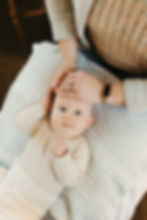The Gentle Power of Craniosacral Therapy for Infants: Science-Backed Benefits
- PW&Lactation
- Jun 3
- 3 min read

Craniosacral therapy (CST) is a gentle, hands-on approach that supports the body’s natural healing processes by releasing tensions in the soft tissues that surround the central nervous system. Though it may sound subtle, this therapy has gained increasing attention in the pediatric world—especially for infants—thanks to its potential to ease discomfort, improve regulation, and support healthy development. But what does the research actually say? Let’s take a look at three key studies that shine a light on the benefits of CST for infants.
1. Relieving Infant Colic with CST
One of the most well-documented applications of craniosacral therapy is in the treatment of infant colic—a condition that leaves parents exhausted and infants inconsolably crying. A 2022 randomized controlled trial by Castejón-Castejón et al. examined the effects of CST on colicky infants. The results were promising: infants who received craniosacral therapy showed a significant reduction in crying time and improved sleep patterns compared to those in the control group.
The study concluded that CST may be an effective non-pharmacological option for treating infant colic. For families seeking gentle, drug-free relief, CST offers a soothing solution that supports both babies and their caregivers.
2. Supporting Preterm and Term Newborns
Preterm infants often face unique challenges with sensory regulation and body tension due to the abrupt transition from womb to world. A 2013 study by Pizzolorusso et al. explored craniosacral strain patterns and somatic dysfunctions in both preterm and term newborns. The research revealed that craniosacral therapy helped identify and address physical strain patterns that might otherwise go unnoticed—but could later affect feeding, sleep, and motor development.
The takeaway? Early CST intervention can play a crucial role in supporting newborns' physical comfort and developmental trajectory, particularly in vulnerable preterm infants.
3. Enhancing Neurodevelopment in Preterm Infants
Neurological development in preterm infants is a delicate process, and early support can make a significant difference. A pilot randomized controlled trial by Raith et al. (2016) investigated the impact of CST on the quality of general movements—a well-established marker of neurodevelopmental integrity. The study found that preterm infants who received CST exhibited more organized and fluent movements, indicating a potential positive influence on their neurological function.
Though the sample size was small, the results suggest that CST could contribute to better neurodevelopmental outcomes when introduced early in life.
Why Parents and Providers Are Taking Note
Craniosacral therapy’s non-invasive, calming nature makes it uniquely suited for infants. It can be used alongside other treatments or as a preventive measure to promote well-being from the very beginning of life. Parents often report improvements in feeding, sleep, digestion, and overall calmness after just a few sessions.
As these studies show, CST is more than just a wellness trend—it’s an evidence-informed practice with measurable benefits. Whether you’re a parent seeking relief for your baby or a provider looking for integrative approaches to care, craniosacral therapy may be worth considering.
Final Thoughts
Infancy is a critical window for development, and gentle interventions like craniosacral therapy can offer meaningful support during this formative time. Backed by growing research, CST offers a safe, compassionate option for helping babies feel better—and thrive.
References:
Castejón-Castejón, M., Murcia-González, M. A., Todri, J., Lena, O., & Chillón-Martínez, R. (2022). Treatment of infant colic with craniosacral therapy: A randomized controlled trial. Complementary Therapies in Medicine, 71, 102885. https://doi.org/10.1016/j.ctim.2022.102885
Pizzolorusso, G., Cerritelli, F., D’Orazio, M., Cozzolino, V., Turi, P., Renzetti, C., & D’Incecco, C. (2013). Osteopathic evaluation of somatic dysfunction and craniosacral strain pattern among preterm and term newborns. The Journal of the American Osteopathic Association, 113(6), 462–467.
Raith, W., Marschik, P. B., Sommer, C., Maurer-Fellbaum, U., Amhofer, C., Avian, A., Löwenstein, E., Soral, S., Müller, W., Einspieler, C., & Urlesberger, B. (2016). General movements in preterm infants undergoing craniosacral therapy: A randomised controlled pilot-trial. BMC Complementary and Alternative Medicine, 16, 12. https://doi.org/10.1186/s12906-016-0984-5